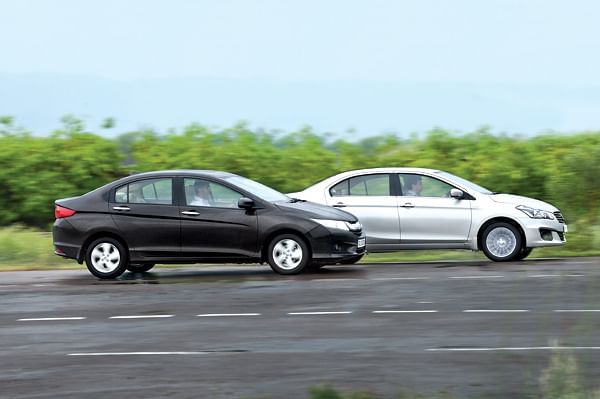Maruti engineers may not say it on record, but if there’s one car they’d like the Ciaz to better, it’s the Honda City. Cars with the City nameplate have been the benchmark among mid-size sedans in India for long, and to beat Honda at its own game would be a huge triumph for Maruti. More so because Maruti has never quite managed to nail the mid-size sedan formula as successfully as other carmakers have, particularly Honda. But while its past sedan attempts in the Baleno and SX4 may have come up short, first impressions of the impressive Maruti Ciaz point to a far closer fight with the segment leader this time around. So, we simply had to find out how Maruti’s best sedan yet squares up against the best City yet.
As you might be aware, these sedans can also be had with petrol engines with the option of manual and automatic gearboxes. But, be it in terms of power or features, the two cars are most similar in fully loaded diesel form. And that’s why we’ve considered the Ciaz 1.3 diesel ZDi+ and the City 1.5 diesel VX for this competition and thrown them into the ring for a no-holds-barred duel.
Elegance vs sport
If you were among those who found the SX4’s crossover-derived shape hard to digest, you’ll like the Ciaz for its conformance to the typical sedan template. It’s a car with nice proportions and a pleasant balance to the design. The rising headlights with the projector elements look neat, the smart 16-inch rims fill the wheel arches well and the chunky C-pillars add a certain solidity to the design. But look at the tail and you wouldn’t be wrong to mistake it for a City’s – the two cars look that similar from this angle. What’s more, they are identical in terms of boot capacity too, with 510 litres of storage space! Before you accuse Maruti and Suzuki’s designers of ‘taking inspiration’ from the City, you should know they would have signed off the final design long before the latest City made its first appearance. Still, if we did have to level a charge at the designers, it would be for playing it too safe. Elegant as the Ciaz is, its styling is a bit bland and unadventurous.

In sharp contrast is the City. Thanks to its arrow shot profile and bold creases on its sides, it looks exciting and sporty. The angular headlights are fantastic too, but that massive slab of chrome atop the grille is perhaps an overkill. A bigger issue, though, are those175/65 profile tyres that sit on 15-inch wheels.
Speaking of size, it’s the Ciaz that’s the larger car here. Just shy of 4.5 metres, it’s 50mm longer than the City in terms of both overall length and wheelbase. The benefit of the latter is clearly evident once we open the rear door.





















.jpg?w=728&q=75)
.jpg?w=728&q=75)











